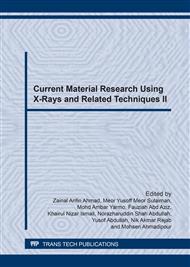[1]
M.K. Lam, K.T. Tan, K.T. Lee, A.R. Mohamed, Malaysian palm oil: surviving the food versus fuel dispute for a sustainable future. Renew. Sust. Energ. Rev. 13(6) (2009) 1456-1464.
DOI: 10.1016/j.rser.2008.09.009
Google Scholar
[2]
V. Sata, C. Jaturapitakkul, K. Kiattikomol, Utilization of palm oil fuel ash in high-strength concrete, J. Mater. Civil. Eng. 16(6) (2004) 623-628.
DOI: 10.1061/(asce)0899-1561(2004)16:6(623)
Google Scholar
[3]
J.H. Tay, Ash from oil-palm waste as a concrete material, J. Mater. Civil. Eng. 2(2) (1990) 94-105.
DOI: 10.1061/(asce)0899-1561(1990)2:2(94)
Google Scholar
[4]
W. Tangchirapat, T. Saeting, C. Jaturapitakkul, K. Kiattikomol, A. Siripanichgorn, Use of waste ash from palm oil industry in concrete, Waste Manage. 27(1) (2007) 81-88.
DOI: 10.1016/j.wasman.2005.12.014
Google Scholar
[5]
A.A. Awal, M.W. Hussin, The effectiveness of palm oil fuel ash in preventing expansion due to alkali-silica reaction, Cement and Concrete Composites 19(4) (1997) 367-372.
DOI: 10.1016/s0958-9465(97)00034-6
Google Scholar
[6]
C. Jaturapitakkul, K. Kiattikomol, W. Tangchirapat, T. Saeting, Evaluation of the sulfate resistance of concrete containing palm oil fuel ash, Constr. Build. Mater. 21(7) (2007) 1399-1405.
DOI: 10.1016/j.conbuildmat.2006.07.005
Google Scholar
[7]
P. Chindaprasirt, S. Homwuttiwong, C. Jaturapitakkul, Strength and water permeability of concrete containing palm oil fuel ash and rice husk–bark ash, Constr. Build. Mater. 21(7) (2007) 1492-1499.
DOI: 10.1016/j.conbuildmat.2006.06.015
Google Scholar
[8]
P. Chindaprasirt, S. Rukzon, V. Sirivivatnanon, Resistance to chloride penetration of blended portland cement mortar containing palm oil fuel ash, rice husk ash and fly ash, Constr. Build. Mater. 22(5) (2008) 932-938.
DOI: 10.1016/j.conbuildmat.2006.12.001
Google Scholar
[9]
J.M. Pérez, J.M. Rincón, M. Romero, Effect of moulding pressure on microstructure and technological properties of porcelain stoneware, Ceram. Int. 38(1) (2012) 317-325.
DOI: 10.1016/j.ceramint.2011.07.009
Google Scholar
[10]
M.Z. Noh, H.U. Jamo, Z.A. Ahmad, effect of temperature and composition of palm oil fuel ash on compressive strength of porcelain, Applied Mechanics and Materials 660 (2014) 173-177.
DOI: 10.4028/www.scientific.net/amm.660.173
Google Scholar
[11]
H.U. Jamo, M.Z. Noh, Z.A. Ahmad, Effect of mould pressure and substitution of quartz by rice husk ash on the bulk density and compressive strength of porcelain body, Materials Science Forum 819 (2015) 134-139.
DOI: 10.4028/www.scientific.net/msf.819.134
Google Scholar
[12]
S.R. Bragança, C.P. Bergmann, A view of whitewares mechanical strength and microstructure, Ceram. Int. 29(7) (2003) 801-806.
DOI: 10.1016/s0272-8842(02)00234-1
Google Scholar
[13]
M.F. Abadir, E.H. Sallam, I.M. Bakr, Preparation of porcelain tiles from Egyptian raw materials, Ceram. Int. 28(3) (2002) 303-310.
DOI: 10.1016/s0272-8842(01)00095-5
Google Scholar
[14]
D. Tonnayopas, K. Kooptarnond, M. Masae, Novel ecological tiles made with granite fine quarry waste and oil palm fiber ash, Thammasat Int. J. Sc. Tech 14(1) (2009) 10-20.
Google Scholar
[15]
W.M. Carty, U. Senapati, Porcelain - raw materials, processing, phase evolution, and mechanical behavior, J. Am. Ceram. Soc. 81(1) (1998) 3-20.
DOI: 10.1111/j.1151-2916.1998.tb02290.x
Google Scholar


